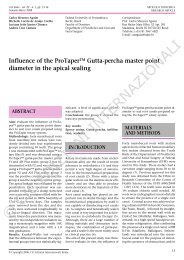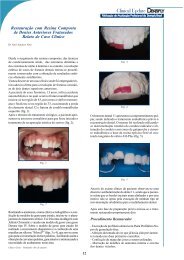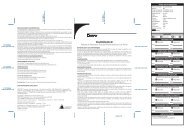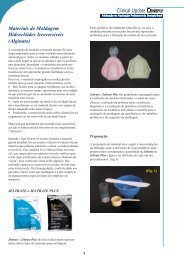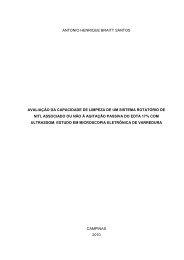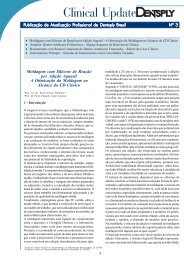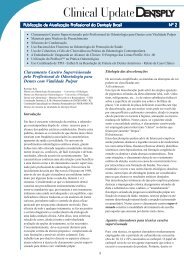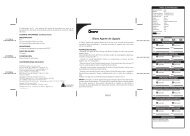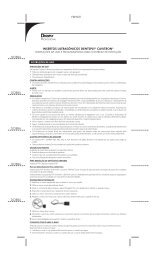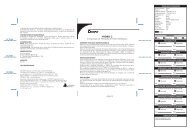Create successful ePaper yourself
Turn your PDF publications into a flip-book with our unique Google optimized e-Paper software.
Shear Bond Strength and Physicochemical Interactions<br />
of XP Bond<br />
Mark A. Latta a<br />
Purpose: The purpose of this study was to evaluate the shear bond strength of composite to dentin and enamel using<br />
the new etch-and-rinse adhesive XP Bond compared to other adhesives (Optibond Solo Plus, Apder ScotchBond 1 XT,<br />
Syntac Classic).<br />
Materials and Methods: Shear bond strength (MPa) was measured by shearing a resin cylinder 4.5 mm in diameter<br />
from prepared buccal surfaces of human third molars using an Instron Testing Machine equipped with a chiselshaped<br />
rod. In addition, micro-Raman spectroscopy was performed to determine if there was a chemical interaction<br />
between the resin adhesive and dentin and enamel.<br />
Results: Significant differences were observed among the dentin and enamel values generated with the adhesives<br />
tested. XP Bond generated statistically similar values to Optibond Solo Plus and Apder ScotchBond 1 XT to both<br />
enamel and dentin. Syntac Classic generated significantly lower values to both enamel and dentin.<br />
Conclusion: Micro-Raman spectroscopy showed a complete infiltration of resin into the demineralized dentin zone. In<br />
addition, it strongly suggested a chemical interaction with XP Bond and components of dentin. It is hypothesized that<br />
this interaction is due to the formation of calcium phosphate complexes derived from mineral apatite in the dentin<br />
and phosphate esters in the adhesive.<br />
Keywords: adhesion, bonding, chemical analysis, Raman spectroscopy.<br />
J Adhes Dent 2007; 9: 245-248. Submitted for publication: 15.12.06; accepted for publication: 11.1.07.<br />
In spite of significant improvements in dental adhesives in<br />
the last decade, achieving a durable bond and seal of<br />
resin based restorative materials still remains a challenge.<br />
The primary mechanism for bonding to dentin with etch-andrinse<br />
adhesives is via the removal of the dentin smear layer<br />
and surface mineral followed by infiltration and entanglement<br />
of resin monomers into the exposed collagen matrix in<br />
the demineralized zone. 2 This resultant mixture of resin, collagen,<br />
and mineral is termed the hybrid zone. 4 The exposed<br />
collagen fibrils are suspended in water, creating space for<br />
a Associate Dean for Research, Professor of General Dentistry, Creighton University<br />
School of Dentistry, Omaha NE, USA.<br />
Paper presented at Satellite Symposium on Dental Adhesives, Dublin,<br />
September 13th, 2006.<br />
Reprint requests: Prof. Mark A. Latta, D.M.D., M.S., Associate Dean for Research,<br />
Professor of General Dentistry, Creighton University School of Dentistry,<br />
2500 California Plaza, Omaha NE 68178, USA. Tel: +1-402-280-5044, Fax: +1-<br />
402-280-5004. e-mail: mlatta@creighton.edu<br />
the penetration of the resin monomers. Drying collagen results<br />
in its collapse and may prevent full infiltration of the adhesive<br />
resin. 3 Clinically, it is difficult to create the optimal<br />
dentin moisture for bonding. However, failure to do so may<br />
lead to postoperative sensitivity, bond failure, leakage, and<br />
ultimately early failure of the restoration.<br />
There are numerous in-vitro testing methods to evaluate<br />
the properties of resin adhesives. While bond strength testing<br />
does not definitively predict clinical behavior, comparison<br />
of new systems with adhesives of known clinical performance<br />
can yield valuable information. 1,5,9 Microscopically,<br />
the interfacial interaction between adhesive and tooth structure<br />
is typically investigated with scanning electron microscopy<br />
and transmission electron microscopy. However,<br />
there is only limited chemical structural investigation of the<br />
resin/tooth interface. The minimal thickness of the<br />
tooth/adhesive interface requires an analytical technique<br />
with very high resolution. Micro-Raman spectroscopy has<br />
been shown to be a very promising technique for investigating<br />
the adhesive bond with tooth structure. 7,8,10,11 It has numerous<br />
advantages, including the ability to analyze speci-<br />
Vol 9, Supplement 2, 2007 245



